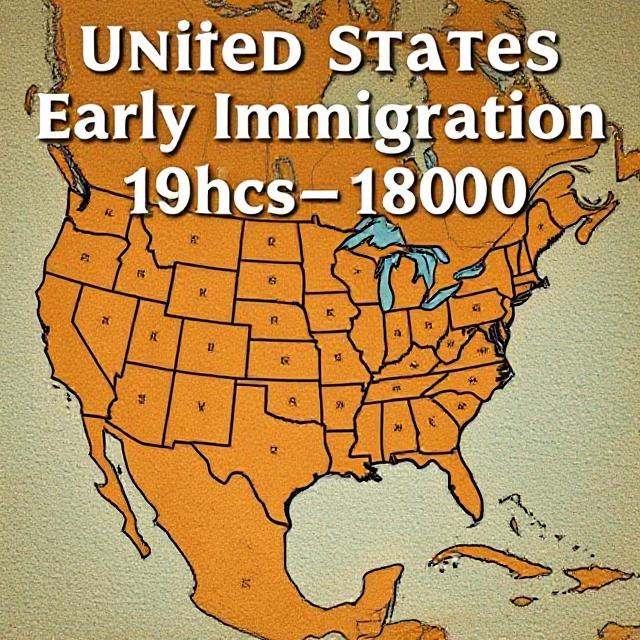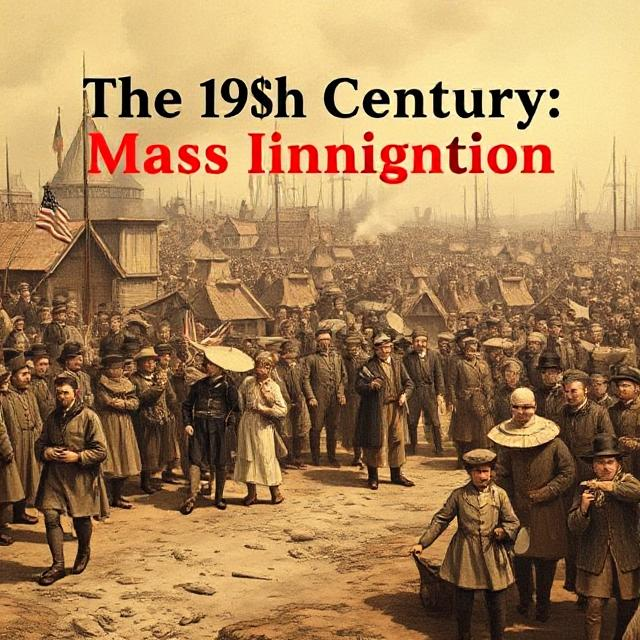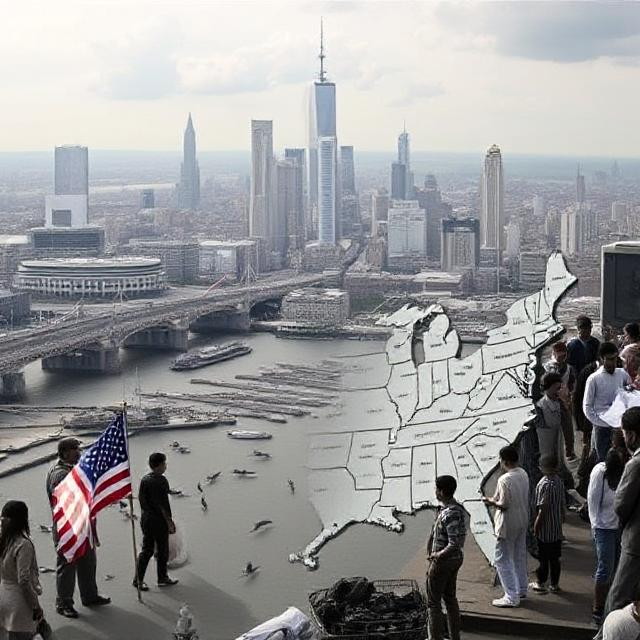The history of immigration to the United States is a rich tapestry woven from diverse cultures, experiences, and motivations. Over the centuries, millions have sought refuge, opportunity, and a better life in America. This article explores the key phases of immigration to the U.S., highlighting significant waves, policies, and the impact of immigrants on American society.
Early Immigration (1600s-1800s)

Colonial Era
The story of immigration to the United States begins with the arrival of European settlers in the early 17th century. The first permanent English settlement was established in Jamestown, Virginia, in 1607. Many of these early immigrants were seeking economic opportunities, religious freedom, or escaping political turmoil in their home countries.
The Role of Indentured Servitude
During the colonial period, indentured servitude became a common practice. Many immigrants, particularly from England, agreed to work for a certain number of years in exchange for passage to America, room, and board. This system helped populate the colonies and laid the groundwork for future immigration patterns. Indentured servants often faced harsh conditions and limited rights, but they represented a significant source of labor in the growing colonies.
The Transatlantic Slave Trade
While many immigrants sought freedom and opportunity, the transatlantic slave trade forcibly brought millions of Africans to the Americas. Between the 16th and 19th centuries, an estimated 12 million Africans were transported to the New World, with about 4 million ending up in what would become the United States. The legacy of slavery has had profound and lasting effects on American society, shaping its economic, social, and political landscape. Enslaved Africans contributed significantly to the agricultural economy, particularly in the South, where cotton and tobacco were dominant crops.
Native American Displacement
As European settlers arrived, Native American populations faced significant displacement and violence. The expansion of settlements often led to conflicts over land and resources, resulting in the forced removal of many Native American tribes from their ancestral lands. The impact of colonization on Indigenous peoples is a critical aspect of the immigration narrative, highlighting the complexities of American history.
The 19th Century: Mass Immigration

The Great Irish Famine
The mid-19th century saw a significant increase in immigration, particularly during the Great Irish Famine (1845-1852). Approximately 1 million Irish immigrants fled to the United States to escape starvation and disease. Many settled in cities like New York and Boston, contributing to the growth of urban centers. The influx of Irish immigrants led to cultural exchanges but also to tensions with native-born Americans, who often viewed them with suspicion and hostility, leading to the rise of nativist movements.
Irish Contributions
Irish immigrants played a crucial role in building America’s infrastructure, working on railroads, canals, and in factories. They also became involved in politics, with many joining the Democratic Party and contributing to the rise of political machines in cities. The Irish community established social and cultural institutions, including churches and schools, which helped preserve their heritage while integrating into American society.
German Immigration
Alongside Irish immigrants, a large number of Germans also migrated to the U.S. during this period, particularly after the failed German Revolution of 1848. Many Germans sought political freedom and economic opportunities. They settled in the Midwest, where they established communities and contributed to the agricultural and industrial development of the region. German immigrants brought with them traditions, foods, and customs that have become integral to American culture.
Contributions to American Society
German immigrants were instrumental in the development of American brewing, agriculture, and education. They introduced new farming techniques and crops, contributing to the agricultural boom in the Midwest. German-language newspapers and schools flourished, reflecting the community’s desire to maintain its cultural identity.
Chinese Immigration
The California Gold Rush (1848-1855) attracted thousands of Chinese immigrants seeking fortune. Many settled in California, working in mines, railroads, and agriculture. However, anti-Chinese sentiment grew, leading to discriminatory laws such as the Chinese Exclusion Act of 1882, which severely restricted Chinese immigration and marked a significant turning point in U.S. immigration policy. This act reflected broader nativist attitudes and fears about competition for jobs and resources.
Impact of Chinese Immigrants
Chinese immigrants played a vital role in the construction of the Transcontinental Railroad, facing harsh working conditions and discrimination. Despite their contributions, they were often marginalized and excluded from mainstream society. The legacy of discrimination against Chinese immigrants continues to resonate today, highlighting the ongoing challenges of racism and xenophobia in American history.
The 20th Century: Restriction and Reform

Immigration Act of 1924
The early 20th century saw a shift toward restrictionist policies. The Immigration Act of 1924 established national origins quotas that favored immigrants from Northern and Western Europe while severely limiting those from Southern and Eastern Europe, Asia, and Africa. This legislation reflected the nativist sentiments of the time and aimed to preserve the “American” character of the nation. The quotas were based on the 1890 census, which disproportionately favored groups already well-represented in the U.S.
Effects of the Quota System
The quota system had profound effects on immigration patterns, drastically reducing the number of immigrants from certain regions. It effectively barred many Jews fleeing persecution in Europe and other groups seeking refuge. This era marked a significant retreat from the previously more open immigration policies of the late 19th and early 20th centuries.
The Great Depression and World War II
The Great Depression (1929-1939) further curtailed immigration, as economic hardships made it difficult for newcomers to find work. During World War II, immigration was heavily restricted, but the war also created a need for labor, leading to programs like the Bracero Program in 1942, which allowed Mexican workers to come to the U.S. temporarily to fill labor shortages. This program reflected the dual nature of U.S. immigration policy, balancing economic needs with restrictive attitudes.
The Bracero Program
The Bracero Program facilitated the legal entry of Mexican laborers into the U.S. for agricultural work, addressing labor shortages during the war. While it provided opportunities for many Mexican workers, it also led to exploitation and abuse, highlighting the complexities of labor immigration.
Post-War Immigration
After World War II, the U.S. experienced a renewed wave of immigration. The Displaced Persons Act of 1948 allowed for the resettlement of refugees from Europe, including Holocaust survivors. The McCarran-Walter Act of 1952 established a preference system for skilled workers and refugees, reflecting a shift toward a more inclusive immigration policy. These acts marked a departure from the restrictive policies of the 1920s and acknowledged the humanitarian needs of displaced populations.
The Late 20th Century: Changes and Challenges

Immigration and Nationality Act of 1965
The Immigration and Nationality Act of 1965 marked a significant turning point in U.S. immigration policy. This act abolished the national origins quotas established in 1924 and prioritized family reunification and skilled immigrants. As a result, immigration from Asia, Africa, and Latin America increased dramatically, transforming the demographic landscape of the United States. The act reflected changing attitudes toward race and ethnicity, emphasizing the value of diversity.
Impact on American Society
The 1965 Act led to a significant increase in the immigrant population, contributing to the multicultural fabric of American society. New immigrant communities established themselves across the country, enriching American culture with diverse languages, cuisines, and traditions. This period also saw the rise of immigrant advocacy groups, which worked to promote the rights and integration of newcomers.
The Refugee Crisis
The late 20th century saw the U.S. become a destination for refugees fleeing conflict and persecution. The Vietnam War led to the resettlement of thousands of Vietnamese refugees, while other conflicts in Central America prompted waves of immigrants seeking asylum. The U.S. established programs to support refugees, reflecting its commitment to humanitarian principles. The influx of refugees from various regions contributed to the growing diversity of American society.
Refugee Resettlement Programs
Programs such as the Refugee Act of 1980 formalized the process for admitting refugees and provided support for their resettlement. The U.S. became a leader in refugee resettlement, welcoming individuals fleeing violence and persecution. This commitment to humanitarianism has been a defining aspect of American immigration policy.
The 21st Century: Contemporary Immigration

Post-9/11 Immigration Policy
The events of September 11, 2001, profoundly impacted U.S. immigration policy. Heightened security measures and the establishment of the Department of Homeland Security led to stricter immigration enforcement and scrutiny. The Patriot Act expanded the government’s ability to monitor and detain immigrants, raising concerns about civil liberties and due process. The focus shifted toward national security, often at the expense of immigrant rights.
The Impact of Security Measures
Increased security measures resulted in longer processing times for visas, heightened scrutiny of applicants, and increased deportations. The post-9/11 climate also fostered an environment of fear and suspicion, particularly toward Muslim and Middle Eastern communities, leading to instances of discrimination and hate crimes.
Immigration Reform Debates
In the 21st century, immigration remains a contentious issue in American politics. Debates over comprehensive immigration reform have centered on issues such as border security, pathways to citizenship for undocumented immigrants, and the status of DACA (Deferred Action for Childhood Arrivals) recipients. Political polarization has complicated efforts to achieve meaningful reforms, with proposals often falling victim to partisan divides.
The DACA Program
Implemented in 2012, the DACA program provided temporary relief from deportation for undocumented immigrants who arrived in the U.S. as children. This program highlighted the complexities of immigration policy, as many DACA recipients often referred to as “Dreamers” have grown up in the U.S. and consider it their home. The future of DACA remains uncertain, reflecting ongoing debates about immigration and citizenship.
The Impact of Immigration
Despite the challenges, immigrants continue to play a vital role in American society. They contribute to the economy, enrich cultural diversity, and fill essential jobs across various sectors. Studies have shown that immigrants are often entrepreneurial, starting businesses at higher rates than native-born citizens. Their contributions have shaped the nation’s identity and continue to influence its future.
Economic Contributions
Immigrants have been integral to the U.S. economy, contributing to innovation, job creation, and economic growth. They often fill labor shortages in critical industries such as agriculture, healthcare, and technology. Additionally, immigrant entrepreneurs have launched successful businesses that create jobs and drive economic development.
Current Trends and Future Directions
The demographics of immigration continue to evolve, with increasing numbers of immigrants coming from Asia, Latin America, and Africa. The U.S. faces ongoing challenges related to immigration, including debates over border security, refugee admissions, and the treatment of undocumented individuals. As society becomes more diverse, discussions around immigration policy will remain crucial for shaping the nation’s future.
The Role of Technology and Cybersecurity
As technology continues to evolve, U.S. foreign policy has increasingly focused on cybersecurity and the implications of digital warfare. The rise of social media and misinformation campaigns has transformed the landscape of international relations, prompting concerns about election interference and the impact of technology on democratic processes. The U.S. government has begun to prioritize cybersecurity as a national security issue, recognizing the need to protect critical infrastructure and democratic institutions.
Conclusion
The history of immigration to the United States is a story of hope, resilience, and transformation. From the early settlers seeking freedom to the diverse waves of immigrants who followed, each group has left an indelible mark on the nation. As the U.S. navigates the complexities of contemporary immigration, understanding this history is essential for fostering a more inclusive and equitable society. The ongoing dialogue around immigration reflects the nation’s values and its commitment to being a land of opportunity for all.



1 thought on “History of Immigration to the United States”